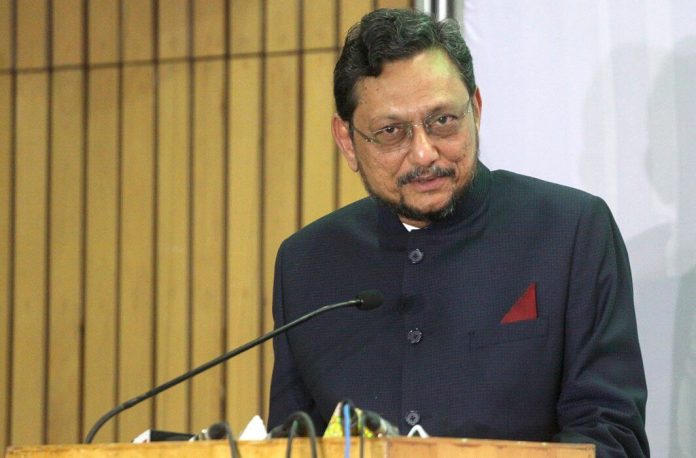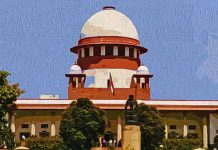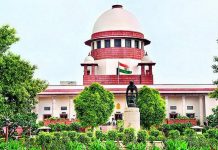This article is written by Manya Dudeja from the University School of Law and Legal Studies, Guru Gobind Singh Indraprastha University. The article draws upon the legacy of the former Chief Justice of India, SA Bobde as he closes his tenure and passes the baton to the next in line.
Table of Contents
Introduction
“I did my best”
-CJI Sharad Arvind Bobde
This is how the 47th Chief Justice of India, S. A. Bobde signed off and bid farewell to the highest judicial office of the country on April 23, 2021. His closing advice to the bar and bench in order to nurture efficient functioning of the judicial system was to develop a relationship of mutual respect. His 18-month tenure is one of the longest for a Chief Justice of India in the last 8 years, yet, it was accompanied by a once in a century challenge the pandemic proposed. The former CJI leaves with his share of positive contributions to the judicial system, as also his share of mess-ups. This article would attempt to acknowledge both and understand the legacy he is leaving behind, examples he set for the next generations to learn from and follow or to learn from and not follow.
Learning point: The power to appoint the Chief Justice of India rests with the President of India, who does so after consultation with the judges of the Supreme Court and the High Courts under Clause (2) of Article 124 of the Indian Constitution. By convention, the senior-most judge of the Supreme Court is recommended to be the next CJI by the outgoing CJI.
CJI SA Bobde and his legal career: An insight
1. Journey as an advocate
Justice Bobde completed his graduation in law from Dr. Ambedkar law college, Nagpur University, and went on to enroll in the Bar Council of Maharashtra in the year 1978. For the next 21 years of his life, he practised before the Nagpur Bench of the Bombay High Court, sometimes in front of the principal seat in Bombay and also, the Supreme Court of India. It was in the year 1998 when Justice SA Bobde was designated as a senior advocate.
2. Journey as a judge
In the year 2000, Justice SA Bobde was appointed as an Additional Judge on the bench of the Bombay High Court. He was appointed as the Chief Justice of Madhya Pradesh High Court in 2012. Then, in the year 2013, Justice SA Bobde was elevated as a judge of the Supreme Court of India. On 18th November 2019, since he was the senior-most judge of the Supreme Court, Justice Bobde took oath as the 47th Chief Justice of India. He succeeded Justice Ranjan Gogoi to the office of the Chief Justice of India. During his eight-year tenure as a Supreme Court judge, Justice SA Bobde authored sixty-eight judgments.
Important judgments passed by SA Bobde as the CJI
As a judge of the Supreme Court and later, as the Chief Justice of India, Justice SA Bobde was a part of a number of benches and pronounced a number of important judgments. Some of these have been remarkable and have been appreciated, while some have been criticized as well. Here, we will have a look at some of the important judgments that speak volumes about the tenure of the outgoing Chief Justice.
1. Lok Prahari v. Union of India
The appointment of retired judges as ad hoc judges in High Courts was cleared by the 3-judge bench comprising CJI Bobde in consonance with Article 224A of the Constitution. This provision had been dormant for the past 58 years. The bench also clarified that these appointments would not be made against the regular vacancies available in the High Courts. The petition was filed by an NGO taking into account the backlog of cases in High Courts. The court also laid down the process through which such appointments can be made.
2. PLR Projects Pvt. Ltd v. Mahanadi Coalfields Ltd
The judgment emphasised on the importance of making quick appointments in High Courts which currently are running with almost a 40 percent vacancy. The court prescribed an 18-week timeline to the Union Government, within which it has to mandatorily complete the process of appointments pending with it for long. The court also stressed on the importance of making recommendations in time by the Chief Justices of the respective High Courts. While 196 recommendations are under process with the government, another 220 are yet to be recommended. The Supreme Court showed worry about the vacancies that would be created in the next six months when the ones already created have not been fulfilled.
3. In Re: To issue certain guidelines regarding inadequacies and deficiencies in criminal trials
This judgment was delivered with the aim to complete the hearings on time and to bring about uniformity in the investigation and trial proceedings of criminal cases. All High Courts have been directed to comply with the Draft Rules of Criminal Practice within six months and make sure that wherever necessary, modifications are made in the orders and practice directions. The State and Union Governments have also been directed to make necessary amendments in their police and other manuals. The rules were originally drafted by senior lawyers, Siddharth Luthra, R. Basanth, and K. Parameshwar.
Use of Artificial Intelligence in judicial functioning
- CJI SA Bobde was the first chairman of the Artificial Intelligence Committee.
- Furthering his idea of using technology in order to improve the efficiency of the judicial system and ease the work of judges, CJI SA Bobde through the Artificial Intelligence Committee, launched three technological portals.
1. Supreme Court Portal for Assistance in Court Efficiency (SUPACE)
This portal has been launched with the aim of data mining, to track the progress of cases, to assist judges with the collection of data, the discovery of facts, processing words and figures to save judges’ time and conduct legal research. Initially, it would be used on an experimental basis by the judges of the Delhi and Bombay High Court to deal with criminal cases.
2. SCI-Interact
By using this all the 17 benches of the Supreme Court can go paperless. This portal would help judges access files, annexures, and notes, which would not be available to other people. There are plans to involve lawyers in the use of this software later to improve the functioning of the courts. It was developed indigenously by the computer cell of the Supreme Court. Further, the software is divided into five components, namely, scanned copies of pending cases, e-filing of fresh cases, IT hardware, MPLS network with dual redundancy, and security audit. The software would help speed up the disposal of cases and minimise human touch, as also facilitate quick decision making.
3. Supreme Court Vidhik Anuvaad Software (SUVAS)
Under this project, Justice SA Bobde aimed at translating judicial documents that are available in English in nine vernacular languages, namely, Marathi, Hindi, Kannada, Tamil, Telugu, Punjabi, Gujarati, Malayalam and Bengali, and vice-versa. It would be done using a machine-assisted translation tool trained by Artificial Intelligence.
Steering through the COVID-19 pandemic
Just like other government institutions, the judicial institution too faced the brunt of the pandemic. The impact on them was more due to the nature of their work of delivering justice to a diverse set of people who may or may not be equipped with the facilities required for accessing the courts virtually.
The pandemic brought the threat of hindering the justice delivery system of the country. It was only after 4 months of CJI SA Bobde’s assuming office that the country went under a nationwide lockdown due to the aggressive spread of COVID-19. However, he has always been a proponent of increased use of technology in the working of the courts and hence he asked the e-court committee headed by Justice D.Y. Chandrachud to speed up the process to start the virtual hearings of the court. Under CJI SA Bobde, the courts continued hearing the cases via the video-conferencing app, Vidyo. The Supreme Court also permitted summons and notices to be served by using the services of email, fax, and instant messaging apps during the pandemic.
Judgments
-
In Re: Guidelines for court functioning through video conferencing during COVID-19 pandemic
Through this order, courts were directed to function via video conferencing and were also directed under Article 142 of the Constitution to reduce the requirement of the physical presence of stakeholders and to maintain social distancing in courts. The Supreme Court and all High Courts were given the authority to adopt technologies suitable for the effective functioning of the judicial system. Proper guidelines were set for the functioning of courts.
-
In Re: Contagion of COVID-19 virus in prisons
In order to deal with the issue of the spread of the COVID-19 virus in prisons, CJI Bobde headed the bench which directed the states and union territories to formulate high-powered committees which were handed over the responsibility to decide which prisoners could be released on bail or parole. It was recommended by the court that prisoners who have been convicted or were undertrial for such offences, the punishment for which as prescribed is up to 7 years or less. Due to this order, thousands of prisoners were temporarily released to avoid a coronavirus explosion in prison cells.
-
In Re: Cognizance for extension of the limitation
Under Article 142 of the Constitution, read along with Article 141, the Supreme Court passed an order and extended the limitation period in all proceedings until any further order was given, this order came into effect on March 15, 2020
-
In Re: Distribution of essential supplies and services during pandemic
This judgment was pronounced just a day before CJI SA Bobde’s retirement. Along with Justice L. Nageshwara Rao and Justice S. Ravindra Bhat, the former CJI suo motu took into account the “grim” situation of the country amid the second wave of COVID-19. The central government was thereby directed to report on the existence of if already formulated, and the requirement of a coordinating body that would, through consultation, allocate COVID-19 resources. It also asked the government to consider COVID-19 related essentials as essential commodities. The government was also asked to report on the coordination of logistical support with respect to inter-State and intra-State transportation and distribution of the resources.
-
In Re: Regarding the closure of mid-day meal scheme
In this case, the court addressed the issue of closure of schools and anganwadis which in turn deprived the students of a nutritious meal that was provided to them. The court ordered all States to ensure that a uniform policy be formulated and nutritional food is provided to children and lactating mothers while curbing the spread of COVID-19. This order was pronounced by a three-judge bench comprising, CJI SA Bobde, B.R. Gavai, and Surya Kant.
Criticism
The former CJI has been criticized for becoming the first Chief Justice of India who failed to make a single elevation to the Supreme Court due to a deadlock in the collegium and also for deferring the hearing of some important cases that came up during his tenure.
- A number of petitions were filed against the controversial Citizenship Amendment Act (CAA), challenging its constitutionality, yet, the matter was heard only thrice in the year 2020 and a final decision regarding the same is still pending.
- The COVID-19 situation also brought with it a huge migrant crisis, with people struggling to reach their homes and deprived of basic resources. Again, several PILs filed for the issue were rejected and it was only after immense pressure from the legal professionals that the Supreme Court took suo motu cognizance of the same.
- The Supreme Court’s stay on the contentious farm laws has also raised important questions of constitutionality. The highest court also failed to gain the trust of the farmers as they refused to negotiate even after the formation of a committee by the Supreme Court.
Conclusion
The internet was stormed with criticism for the former CJI SA Bobde as soon as he passed the baton on to the 48th Chief Justice of India, Justice N.V. Ramana. A lot of articles went on to talk about his inefficiencies as a CJI in reply to which his former law clerk and currently an advocate in the Supreme Court, Roddam Prashanth Reddy, also wrote an article praising the former CJI and the way he steered the judiciary through the pandemic. He rightly pointed out that no one is perfect and it remains up to us to talk about all his inefficiencies using free media or acknowledge his efforts and contributions to the growth of the judicial system.
Credit must be given where it is due, CJI Bobde has been vocal about his vision that he would like to witness India have its first female Chief Justice of India very soon.
Healthy and controlled criticism is what makes the institutions understand their shortfalls and strive to do better. However one may understand it, CJI SA Bobde completed his part and bid adieu to the judicial service. Now it is for Justice N.V. Ramana to take up from here the place he has earned during these testing times and drive the vehicle of justice, picking up a people grieved by the government’s irresponsibility and inability.
References
- https://economictimes.indiatimes.com/news/politics-and-nation/supreme-court-develops-software-to-make-all-its-17-benches-paperless/articleshow/75989143.cms?from=mdr
- https://thewire.in/law/cji-sa-bobde-legacy-high-court-pendency
LawSikho has created a telegram group for exchanging legal knowledge, referrals and various opportunities. You can click on this link and join:
 Serato DJ Crack 2025Serato DJ PRO Crack
Serato DJ Crack 2025Serato DJ PRO Crack











 Allow notifications
Allow notifications



